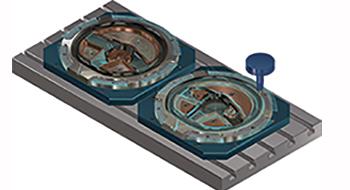
CNC Software announces the release of Mastercam 2018. Mastercam 2018 brings a new suite of programming tools focused on delivering speed, automation and efficiency for all machining jobs. Mastercam 2018 offers new 2D/3D Milling features, Design improvements, and powerful turning and Mill-Turn enhancements.
Stock awareness has been added to select 2D toolpaths and allows tool motion on the top, bottom, or both values of the stock. This provides a safer and more optimized tool motion. You can also optimize finish passes based on your rough stock, giving you more efficient and safer tool motion. The workflow for all 3D high-speed toolpaths has been streamlined and gives you fine control over exactly where to cut. High-speed hybrid toolpaths now offer smoothing controls and deliver a finer finish, requiring less handwork.
If you work with stringy materials such as aluminum or plastic, Mastercam’s new Chip Break control prevents problems by allowing you to set length and time conditions, retract, and dwell options. Mill-Turn machine definitions now contain tailstock and quill components, tailored to your machine.
Exclusive to Mastercam, a new set of turning strategies automate toolpath generation and support for Sandvik Coromant CoroTurn Prime inserts and PrimeTurning method. PrimeTurning provides superior metal-removal rate, productivity gains of over 50 percent and increased tool life in a variety of materials.
Shops can model their own designs, but they also get in models that need to be corrected or prepped for machining. Mastercam’s CAD functions are designed for the machinist. Angle Sweep improves the creation of more complex wireframe functions and when creating or editing primitives, there are now on-screen sweep and rotate controls which can snap to the AutoCursor positions of existing entities. To make Roll and Unroll results easier to predict, Seam Control lets you visually rotate a seam to see how geometry will respond, as well as snap to AutoCursor positions. Hole Axis makes it easier to work with a large number of holes, especially holes with matching diameters that are selected as a group.
Also available in the Mastercam 2018 release is:
- My Mastercam gives you access to your profile, Mastercam’s social media outlets, your Reseller information, the Mastercam Forum, and other helpful information.
- Streamlined workflow with improved plane management, level and geometry control, toolpath analysis and more.
- Model Prep and Solid Model enhancements such as Multiple Undo/Redo for up to twenty-five functions and Solid Sweep has more options and controls than ever.
- The Collision Control and the Multiaxis Link Safety Zone pages for Multiaxis toolpaths have been redesigned for Mastercam 2018.
- Common direction has been added to the Tool Axis Control page for Multiaxis toolpaths and keeps the tool at a uniform tilt angle to reduce tool and machine motion.
- And many other productivity improvements across the entire product.
Contact Details
Related Glossary Terms
- computer numerical control ( CNC)
computer numerical control ( CNC)
Microprocessor-based controller dedicated to a machine tool that permits the creation or modification of parts. Programmed numerical control activates the machine’s servos and spindle drives and controls the various machining operations. See DNC, direct numerical control; NC, numerical control.
- computer-aided design ( CAD)
computer-aided design ( CAD)
Product-design functions performed with the help of computers and special software.
- gang cutting ( milling)
gang cutting ( milling)
Machining with several cutters mounted on a single arbor, generally for simultaneous cutting.
- metal-removal rate
metal-removal rate
Rate at which metal is removed from an unfinished part, measured in cubic inches or cubic centimeters per minute.
- milling
milling
Machining operation in which metal or other material is removed by applying power to a rotating cutter. In vertical milling, the cutting tool is mounted vertically on the spindle. In horizontal milling, the cutting tool is mounted horizontally, either directly on the spindle or on an arbor. Horizontal milling is further broken down into conventional milling, where the cutter rotates opposite the direction of feed, or “up” into the workpiece; and climb milling, where the cutter rotates in the direction of feed, or “down” into the workpiece. Milling operations include plane or surface milling, endmilling, facemilling, angle milling, form milling and profiling.
- solid model
solid model
3-D model created using “building blocks.” This is the most accurate way of representing real-world objects in CAD.
- toolpath( cutter path)
toolpath( cutter path)
2-D or 3-D path generated by program code or a CAM system and followed by tool when machining a part.
- turning
turning
Workpiece is held in a chuck, mounted on a face plate or secured between centers and rotated while a cutting tool, normally a single-point tool, is fed into it along its periphery or across its end or face. Takes the form of straight turning (cutting along the periphery of the workpiece); taper turning (creating a taper); step turning (turning different-size diameters on the same work); chamfering (beveling an edge or shoulder); facing (cutting on an end); turning threads (usually external but can be internal); roughing (high-volume metal removal); and finishing (final light cuts). Performed on lathes, turning centers, chucking machines, automatic screw machines and similar machines.
